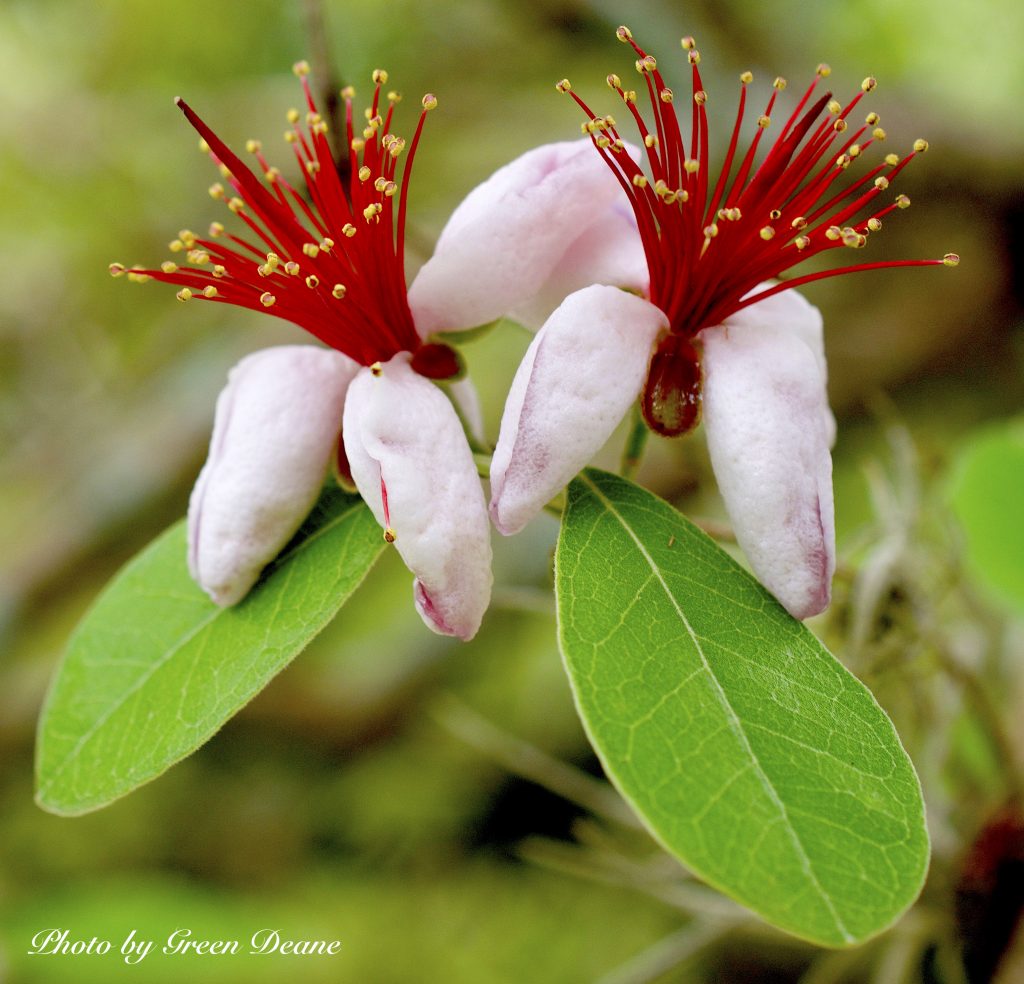
Pineapple Guava blossoms are edible and peppery. Photo by Green Deane
Perhaps no ornamental was championed as much as the Pineapple Guava. However the perfect shrub for many places never really caught on. There could be several reasons. It probably didn’t help that a close relative, the Strawberry Guava, is a severe invasive species in some locations. The shrub also does not get showy. You have to hunt for the extroverted blossoms. While the entire blossom is edible most people only eat the petals. Five or six months from now they will be dark green fruit that stay green as they ripen. They just get softer. The shrub is easy to identify when in blossom. To read more about both guavas, go here.
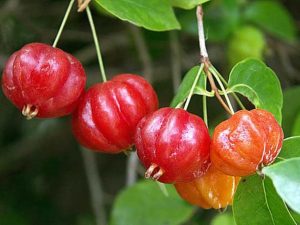 Surinam Cherries, which are not really cherries, can have a wide fruiting period. So far this season I have found shrubs with tiny green fruit to a large tree-shaped specimen already dropping ripe fruit. I think the latter has jumped the season significantly. There are two varieties, black fruited and deep red fruited. Surinam Cherries taste awful until totally ripe. Even then many folks do not like the flavor. Your pallet will either say this is food or this is not. No in betweens. Seriously. You either will eat them again or never again. But if you are going to eat them make sure they are very ripe. In the black/dark purple variety they are indeed black when totally ripe. With the red-fruiting variety you want a deep fire-truck red (with blue tones) not an orange Ferrari red. To read more about Surinam Cherries go here.
Surinam Cherries, which are not really cherries, can have a wide fruiting period. So far this season I have found shrubs with tiny green fruit to a large tree-shaped specimen already dropping ripe fruit. I think the latter has jumped the season significantly. There are two varieties, black fruited and deep red fruited. Surinam Cherries taste awful until totally ripe. Even then many folks do not like the flavor. Your pallet will either say this is food or this is not. No in betweens. Seriously. You either will eat them again or never again. But if you are going to eat them make sure they are very ripe. In the black/dark purple variety they are indeed black when totally ripe. With the red-fruiting variety you want a deep fire-truck red (with blue tones) not an orange Ferrari red. To read more about Surinam Cherries go here.
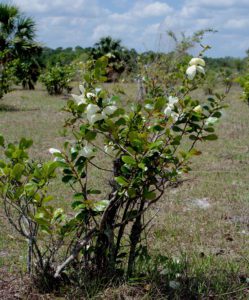
Pawpaws are easy to spot now.
Once you’re done reading this newsletter turn off the computer and go find some Pawpaws. Now is the time locally to identify one of the more common species we have. The photo to the left is from a pasture in Volusia County near Gemini Springs. There are hundreds of Pawpaw blossoming there now and all along the bike trail through the area (as well as true thistles and Maypops.) In a few months there will be a lot of fruit here if the woodland creatures don’t get to them first. It is, after all, their grocery store. We have Pawpaws with cream-colored blossoms and some dwarf versions with purple blossoms. While you can find them in nearly any dry location pastures are a good place to look because pastures are easy to find and livestock tend to not eat them. This is one species you can also find while driving. Just look for five-foot shrubs with cream-colored blossoms as you go by. You will see Pawpaws. To read more about Pawpaws go here.
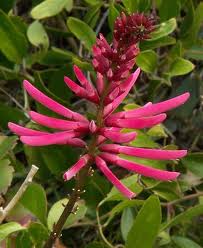
Humming birds like the Eastern Coral Bean
Also blossoming this time of year is the Eastern Coral Bean, sometimes called the Cherokee Bean. What is odd about this plant is the edible flowers produce toxic beans. So we do not eat the red and black beans. A few of the red blossoms are edible raw — with precautions — but they are usually boiled then mixed with other foods notably scrambled eggs. When you cook the blossoms they turn light green. The distinctive shape of the leaves makes the shrub easy to identify. Young leaves are edible cooked but are marginal fare. Like the Pawpaws above they prefer dry, sunny places. A few raw red blossoms seem okay but if eaten in larger amounts they can be mind altering and approaching dangerous. Boiled they are fine. (Juice from the shrub’s stems, by the way, has been used to treat scorpion stings.) You can read more about the Eastern Coral Bean here.
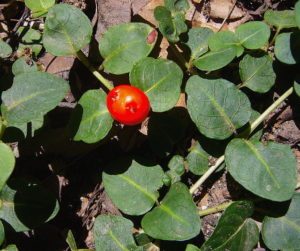
Partridgeberry. Photo by Green Deane
In the Carolinas in August I see a lot of Partridgeberries, also called Twin Berries because the separate blossoms fuse into one berry. They are edible but mild. That said partridgeberries are attractive with striking red berries and deep green leaves. They are not extroverted but if you see them the little fruit are attractive. I have seen them Gainesville and Wekiva State Park just north of Orlando. According to the USDA chart the species is not in the county but U.S.D.A. maps are often quite out of date. Seasonally Florida and the mountains of North Carolina are — as far as the Partridgeberries are concerned — about five months apart. As with the Carolinas these were spotted in damp but not inundated soil. You can read more about them here.
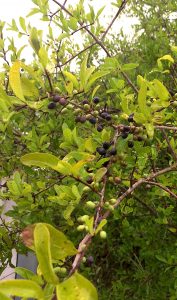
Foresteria segregata
Odds and ends of the weekend: What’s the old saying? Close but no cigar. This weekend I saw two plants, one I had never seen and one I had not seen in many years. The latter was Foresteria segregata, in Largo, Florida. Also called Florida Privet and Swamp Privet, you can find it anywhere from brackish waterways to an intentional ornamental in landscaping. The straight limbs were used for arrows and the blue berries possibly used for ink. I suspect the species has never worked its way into ethnobotanical literature because the berries taste bad. I’m not sure, however, if the story ends there. Yes, the berries are not considered edible. That said I have not found any references to toxicity but that might be because they are too foul to eat. However, it is in the Olive family and olives don’t taste good unless “cured.” What I wonder is 1) if the fruit are edible if 2) they are treated (meaning cured) like olives? It’s pure speculation on my part. They could be toxic for all I know. But it’s an idea.
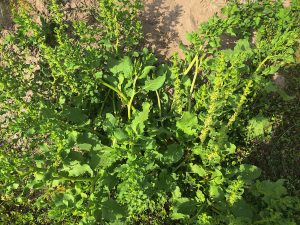
Rumex paraguayensis
The other plant looked like a “dock” to me, also called Rumex. There’s about a dozen and a half Rumex in North America, many of them native while several imported. Merritt Fernald, who was the main botany Ph.D. at Harvard for half a century, said they were all edible but most of them bitter. We have several locally: R. hastatulus and R. acetosella are tart, the latter not native. R. verticillatus, the Swamp Dock, is also commonly seen and bitter. Two other introduced species locally — and in the rest of North America — are Rumex obtusifolius and Rumex Crispus, the latter also know as edible Curly Dock. The “dock” we saw in Cassadaga, Fl, didn’t seem to be any of those. Because there were a lot of small leaves on the flower spike it could be R. paraguayensis, which is reported in the state but in limited locations. If it is R. paraguayensis is it edible? That took a bit of digging. I found an article called “Wild Food Plants and Fungi Used By The Polish Community in Misiones, Argentia” published in the Journal of Human Ecology, December 2015. The fifth entry on Table One says R. paraguayensis leaves were eaten raw in salads and cooked in soups. It was also not listed as a famine food. You can read the full article here.
And another reminder that loquats are in full fruit now and wild garlic is in season. In fact at our Largo class were were taken to a wild garlic location. Thanks Carolyn! Oh yes, in last week’s top photo the edibles were Dandelions, Oxalis, Commelina, and False Hawk’s Beard. There’s also a young nightshade that if allowed to grow probably would have been Solanum americanum. I say been because the lawn has since been mowed.

Green Deane Forum
Want to identify a plant? Looking for a foraging reference? Do you have a UFO, an Unidentified Flowering Object you want identified? On the Green Deane Forum we chat about foraging all year. And it’s not just about warm-weather plants or just North American flora. Many nations around the world share common weeds so there’s a lot to talk about. There’s also more than weeds. The reference section has information for foraging around the world. There are also articles on food preservation, and forgotten skills from making bows to fermenting food. One special section is “From the Frightening Mail Bag” where we learn from people’s mistakes. You can join the forum by clicking on the button on the upper right hand side of this page.

Green Deane DVD Set
Spring orders have started their annual increase. All of Green Dane’s videos available for free on You Tube. They do have ads on them so every time you watch a Green Deane video I get a quarter of one cent. Four views, one cent. Not exactly a large money-maker but it helps pays for this newsletter. If you want to see the videos without ads and some in slightly better quality you can order the DVD set. It is nine DVDs with 15 videos on each. Many people want their own copy of the videos or they have a slow service and its easier to order then to watch them on-line. They make a good gift for that forager you know. Individual DVDs can also be ordered. You can order them by clicking on the button on the top right of this page or you can go here.

Classes are held rain or shine or cold.
Foraging Classes: Foraging classes this week range from mid-state in Orlando to the southwest side and Sarasota. While some winter plants remain the spring edible are making their seasonal run so there’s plenty to see and taste.
Saturday, April 14th, Blanchard Park, 10501 Jay Blanchard Trail, Orlando, FL 32817. 9 a.m. Meet at the pavilion east of the tennis courts near the YMCA.
Sunday, April 15th, Red Bug Slough Preserve, 5200 Beneva Road, Sarasota, FL, 34233, 9 a.m.
Saturday, April 22nd, Spruce Creek, 6250 Ridgewood Ave. Port Orange, 32127, 9 a.m., meet at the pavilion.
Saturday, May 5th, Florida State College, south campus, 11901 Beach Blvd., Jacksonville, 32246. 9 a.m. We will meet at building “D” next to the administration parking lot.
To read more about the classes or to pre-pay go here.
 Donations to upgrade EatTheWeeds.com and fund a book are going well and has made the half way mark. Thank you to all who have contributed to either via the Go Fund Me link, the PayPal donation link or by writing to Green Deane POB 941793 Maitland FL, 32794. Recent upgrades have been paid now the Forum needs work and several function problems need to be fixed specifically the search and categories. A new server also being considered. The other issue is finding an indexing program or function for a real book. Writing programs used to do it automatically if you designated a term for indexing. Now that most books are ebooks most writing programs do not provide and indexing function.
Donations to upgrade EatTheWeeds.com and fund a book are going well and has made the half way mark. Thank you to all who have contributed to either via the Go Fund Me link, the PayPal donation link or by writing to Green Deane POB 941793 Maitland FL, 32794. Recent upgrades have been paid now the Forum needs work and several function problems need to be fixed specifically the search and categories. A new server also being considered. The other issue is finding an indexing program or function for a real book. Writing programs used to do it automatically if you designated a term for indexing. Now that most books are ebooks most writing programs do not provide and indexing function.
Foraging is more than identifying edible wild plants. It also involves knowing how to cook them, when they are prime to harvest, and subject of this review, where to find them. In real estate the mantra is “location, location, location.” We could use that with plants but a refinement would be “environment, environment, environment.”
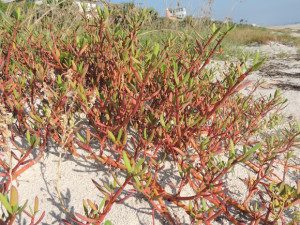
Sea Purslane tolerates salty ground.
We know not to look for swamp plants in a desert, unless there is an isolated spring there such as an oasis. Likewise, few cactus grow in swamps though there are exceptions. We also usually find salt tolerant plants near the shore or inland near salt licks (and sometimes along northern roads salted every winter.) But some of those salt-tolerant plants will grow in your garden and do not need to be in a salty environment. Sea Purslane is found on the shore or near brackish water where its job is to build soil by forcing the wind to slow down and drop sand. But, it will also grow in your garden, no salt or wind needed. Other plants are more picky and won’t grow well if not in their preferred location.
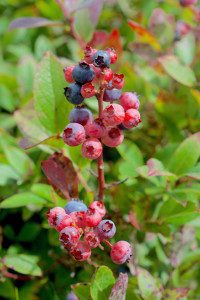
Blueberries, Roan Mt. North Carolina.
For example, one species I am long-familiar with is Blueberries. They like soil on the acidic side, a pH below 7 on a 14-point scale. I grew up in poor-soil Maine where one could find 120-acre fields of nothing but Blueberries. Yet where I live now, in Florida, Blueberries are found in small colonies in isolated pockets. Why? One answer is Florida is a limestone plate (alkaline not acidic) so it is a waste of time to look for Blueberries unless there are acid-producing pines, oaks or perhaps cypress nearby. I planted Blueberries specifically bred for Florida but one has to amend the soil — the amount of acid — nearly as much as one has to work daily to keep a pool from turning green. They eventually died, one of my few failures.

Dandelions like acidic soil.
Another example is Dandelions. I have observed for several decades that Dandelions don’t like Florida, or at least the areas of Florida I visit. They like acidic soil. It might be it is not Florida’s heat they don’t like but rather the alkaline (“sweet”) soil. The few places I have seen Dandelions growing have been areas of acidic soil again near pines and often oaks. Dreher Park in West Palm Beach is a good example. What Dandelions there are there can be found growing in lawn grass amongst oaks. While I have also found Dandelions around the year they tend to favor the winter months such as November through February. With environment in mind let’s survey some plants and what soils and conditions they like.
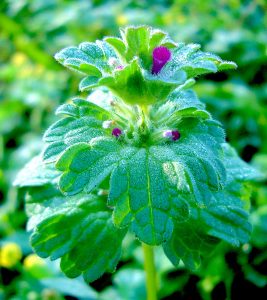
Henbit, one of the few “sweet” springtime greens. Photo by Green Deane
Some plants can do well in nearly any soil. Henbit, Dead Nettle and Shepard’s Purse are good examples. However, a close relative of Shepard’s Purse, Poor Man’s Pepper Grass, likes soil on the alkaline side. This means you probably won’t find Pepper Grass near Pines and Oaks. Plants that like acidic soil (below a pH of 7.0) that you can find near Oaks and Pines include Eastern Bracken Fern, Curly Dock, Mullein, Nettles, Violets, Pineapple Weed, Plantagos, Wild Radish, Sheep Sorrel, Sow Thistle, and wild Strawberries. Plants that like it on the “sweet” or alkaline side besides Pepper Grass? Wild Carrots, Lamb’s Quarters, Amaranth, Pokeweed, White Mustard, and Purslane. Don’t look for those in an oak scrub or with a lot pines around.
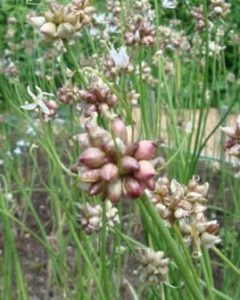
Wild Garlic likes thick soil.
Besides the pH of soil the kind of soil can make a difference. Chicory likes “heavy” soil meaning lots of clay, or rocks. Also liking heavy soil is Broadleaf Dock, Daisies, Milkweed, Plantains, true Thistles, and Wild Garlic. Plants that can endure hard packed soil include Field Mustard, Morning Glories — some of which are edible — and Pineapple Weed (it used to grow in our gravel driveway.) Going the other directions, plants that like sandy soil include Goldenrods, Sandspurs and Spurge Nettle. Plants too look for in agricultural soil include chickweed, Dandelions, Lambs Quarters, Plantains, Amaranth and Purslane. And while Florida Betony can grow edible roots in rich loam or sand it tends to grow larger and easier to harvest roots in sand.
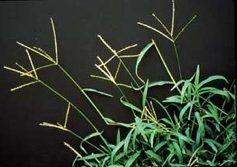
Crab Grass likes low calcium soil.
By their very presence some plants can tell you about what’s in or not in the soil. Burdock likes soil very high in iron and sulfate but low in calcium and manganese. Chickweed and Dandelions like low-calcium low-phosphorus soils. Crabgrass likes very low levels of calcium, phosphorus but high levels of chlorine, magnesium and potassium. Oxalis and Hop Cover, however, prefer low levels of calcium but high levels of magnesium. Purslane and Mustard like high phosphorus levels.
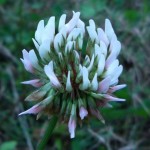
Clover prefers low nitrogen soil.
If you see a healthy patch of White Clover you know the soil is lacking in nitrogen. Or said another way, you won’t find happy White Clover in nitrogen-rich soil. I suspect that holds true for other members of the pea family as well. Because of preferences you will usually not find amaranth and clover growing together. Red Clover, however, prefers to grow in areas of soil high in potassium. Wild Garlic also likes high potassium as well along with chlorine, magnesium, and sodium.
This is weekly issue 299.
If you would like to donate to Eat The Weeds please click here.


Thanks for the info about pineapple guava. I have that and a PawPaw tree in my yard but never see them anywhere else in NW Fla. 🙂
interested in the spruce creek outing, more details please
The classes are about four hours long, we walk a couple of miles, there’s water, parking and bathrooms. We will see between four and six dozen edible species.
Apart from the proper nomenclature, I ‘d like to mention that at present we have abundant amount of guava fruits – both yellow and light green skin types . Here in Sudan my people don’nt speak of ” invasive ” species . Now , before me is a cup of tea prepared from the leaves of , let’s say ” common guava ” or ,according to your article ” Strawberry guava ” or even more accurately a domisticated species of it , ready for me to take as cure to a persistant cough .
The beautiful picture of ” Dandelions like acidic soil ” reminds me of the happy time my family had in Hilton Hotel during our stay in Quatar last year where one could have felt both the beauty of the flower in the pot and the delicious food supplied in their restuarant . Thank you Deane for your great effort.